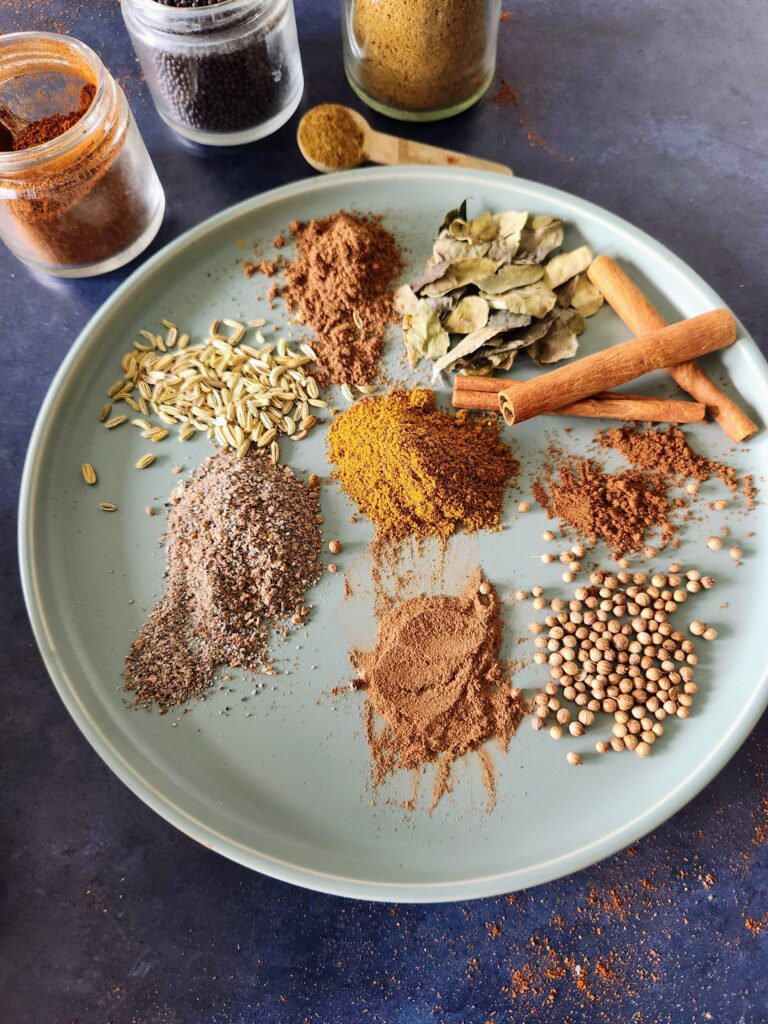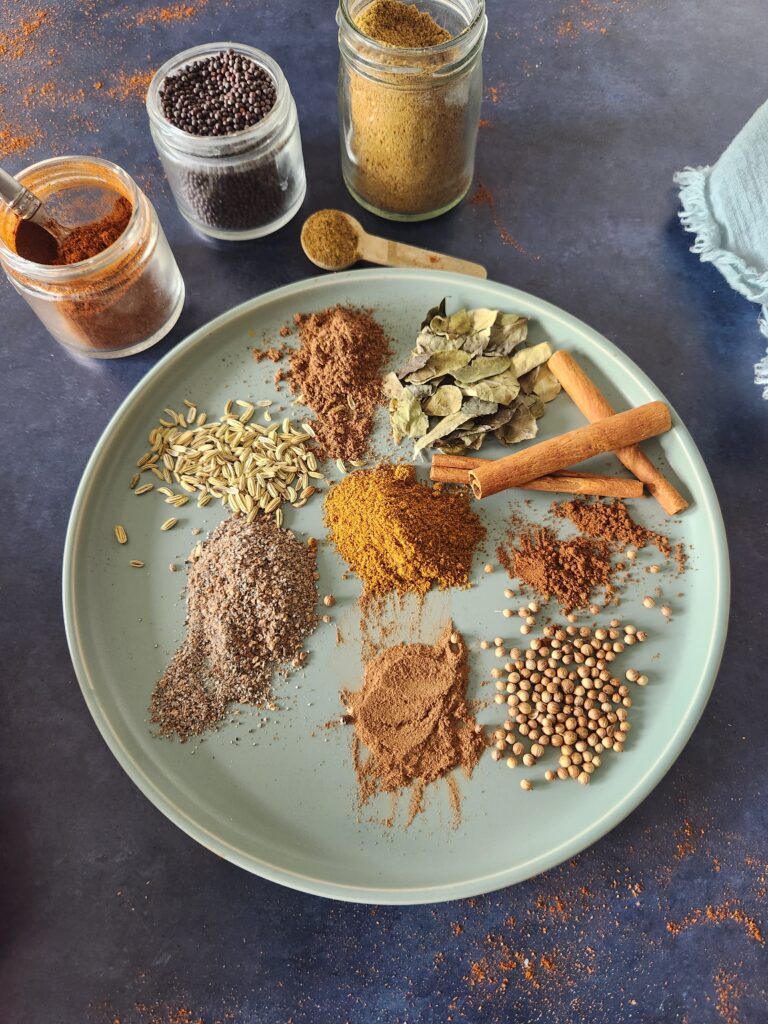There really is a simple formula for making many of the curries you love to eat at your favorite Indian restaurant!
Foundation + Spices + Body = Curry.
Disclaimer
We are not Indian, we do not have Indian roots, but we are fanatics about Indian food. Our basic “Indian” Curry Formula is based on food we’ve tasted at Indian and Pakistani restaurants here in the United States and in Great Britain.
And yes, we know many of the dishes we’ve experienced are in no way authentic to the many different regional dishes found in India, but they are delicious, and delicious is something we get behind all day long!
Further Disclaimer: Updated June 5th, 2023 because when this post was first written, we didn’t know how to write blog posts! Update contains the same information, but written much more clearly and with additional images added!
SpiceTopia Curry Formula
Most of the dishes we enjoy at Indian Restaurants can all be made with this formula.
- Foundation
- Spices
- Body
Foundation

A curry foundation is simply the base of a curry. It is the first layer of flavor.
In French dishes, this foundation is a mirepoix or a mix of carrots, onion, and celery. The “Holy Trinity” of onion, green bell peppers, and celery form the foundation of most Creole dishes.
The foundation in our Indian curry formula is no different. Onions, ginger, and (sometimes) garlic cooked together create the base layer of flavor.
What’s up with the sometimes garlic? Well, there appears to be a debate about including garlic in the foundation as the flavor can be strong. We tend to leave it out as it can easily burn and turn bitter. Most dishes have enough other flavors that garlic isn’t missed.
So, finely dice your onion, grate your ginger, and saute over a medium low heat in ghee or if you want a plant-based or vegan dish use a high-smoke point oil such as grapeseed or coconut oil. Add salt at this step as most curry powders are salt-free.
Depending on whether the dish is a lighter dish or a deeper flavored dish, cook the onion until it is just soft–or cook until it turns deep brown and caramelizes. Not sure which works for the dish you are cooking? Don’t worry–you’ll learn as you go, and we promise either way will result in a delicious dish.
Spices

Next comes your spices. As a beginner, it is easiest to pick out a curry powder and use those pre-blended spices. As you gain experience, you’ll want to bump up certain flavors and add extra spices, but a basic curry powder will serve you well as you learn to create curries.
At SpiceTopia we offer several curry blends.

- Lemon Curry Powder is bright without a lot of heat.
- Madras Curry Powder is the most traditional curry blend with just barely a kick of heat.
- And if you are looking for heat, our Muchi Curry Powder is much spicier than our Madras Curry Powder and pairs well with coconut curries.
- Vindaloo Curry Powder is a tomato based curry blend from the Goa region of India and is also quite spicy!
When making a curry, start with at least a tablespoon of curry powder. It may seem like a lot, but the spices are flavoring a whole dish. Also keep in mind, the spices will be acting like flour in a roux and thicken your curry.
To add your spices to your prepared foundation:
- Push the foundation mixture of onion and ginger to the edges of your pan.
- If the pan appears dry, add a teaspoon of oil and let it heat up for about a minute.
- Then add your curry powder, stir into the oil, and cook for another minute or so. This step is important as the spices need to cook–or bloom- in the oil, so they don’t taste raw. Blooming or tempering your spices allows the natural oils of your spices to awaken and bring out their flavor.
- After the spices have cooked for about 1 minute, stir together the spices and foundation.
The Body

Now you are ready for the body of your curry. The body consist of any of the following or a combination of the following:
- yogurt
- coconut milk
- cream
- tomatoes
- spinach
- peppers
- butter
- plant-based milk
Think of your favorite Indian dish and what body it has.
Tikka Masala has a body of tomato and cream.
Saag Paneer has a body of pureed spinach.
Kadhi has a body of yogurt.
Don’t be afraid of mixing and matching. Experimenting with what you have in your pantry is also a great way to discover new combinations.
The Last Step Of Creating Curry
Your last step is to enjoy your curry as is or to add a protein or veggie of your choice.
That protein could be chicken, beef, lamb, or seafood. You can also make a curry with chickpeas, white beans, or lentils. Potatoes is a popular vegetable added to many curries, but really any vegetable will work! Think green beans, broccoli, cauliflower, spinach, cabbage, tomatoes, sweet potatoes, or squash. The possibilities are endless.
Looking for Inspiration for Your First Curry?
Our Potato Vindaloo Curry Recipe is an easy Indian recipe to get you started on your journey into curry! It is a spicy recipe, but if spicy isn’t your thing feel free to substitute our mild curry powder for the vindaloo curry powder.
Want to learn more about Indian Flavors?
Our blog posts:
Unveiling the Flavors and Spices of Northern India and
The Story of the Flavors and Spices of Southern India will help you explore and understand the foods of these two regions.
If you’d like to move beyond using curry powders to create Indian food, we have several recipes for you to try!
Butter Chicken (Murgh Makhani)
Indian Spinach & Potatoes Curry (Saag Aloo)
If you ever have any additional questions about cooking with curry powders, leave a comment! We’d love to help answer them!

SpiceTopia’s Curry Formula
Instructions
Note
Serve over rice. We love a dollop of Zesteez Chutney on top!
What curry will you create with this formula?


